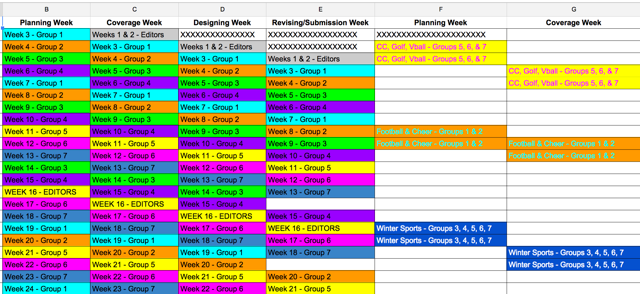Chronological Coverage: How My Editors Convinced Me It Was Time to Try It
January 30, 2015
When I started as a high school yearbook adviser two years ago, the editors who were already in place had a clear plan for the book they wanted to create. And their plan included traditional coverage broken into three thematic sections. So I jumped in and learned the basics of running a yearbook program while creating a book with traditional coverage – a spread for each sport, a spread for each academic subject, and a spread for various student life categories like “weekends” and “trends.” We produced a book with content we were proud of that year, winning awards for photography and storytelling. Year two, my editors decided on traditional coverage again with one exception – they wanted to use umbrella coverage for the academics section. That worked well for us too – it allowed us to find the best stories for those pages with creative umbrella topics that held all of it together on a spread. This lent itself to better photography opportunities and we showcased more students in authentic pieces of coverage. Another successful book we were proud of arrived in June.
And then my newly selected editor-in-chief made a grand announcement – she wanted our next book to be chronological if it fit the theme they were working on. She’d seen impressive examples of chron books at yearbook workshops and camps we had attended and she was convinced this was the best way to tell the stories in our school. Meanwhile, I’d been seeing the same impressive examples and talking to other local advisers who made those chron books – and I had the complete opposite reaction! Chronological coverage looked complicated and complex with lots of moving parts, extensive spreadsheets for tracking what stage of production each team was in during any given week, and calendars for submission and coverage that made my head spin. The ladder looked like a puzzle I couldn’t solve. I saw chronological as something that OTHER schools could tackle but that we (or more accurately, I) had no business touching without more overall yearbook experience. Chron looked like something only the pros did!
But I listened to my student editor who was excited and ready for the challenge of chron. She said it would be great. She said it would change our way of doing things for the better. And not surprisingly, she was right.
Here’s some of the best lessons we’ve learned about what chronological coverage can do for you and your staff!
- Staffers and editors are doing real journalism when they’re doing chronological coverage.
With chron, staffers have to be actively covering school events, social media trends, classroom activities and field trips, and all the other things that go on at school that week. So suddenly instead of trying to “fill” a spread with content from a pre-determined category (academic clubs, math classes, or volunteering, for instance), yearbook staffers are telling the stories that are relevant and engaging from that week. It also helps them to focus their reporting. There’s no more “you have two weeks to plan, two or three weeks to collect content, and then time to design the spread.” Instead, all the stories have to be collected, researched, fact-checked, and reported on during one week. Staffers are less likely to procrastinate and more likely to dig up interesting story angles because there’s no time to waste. And when the interviews, photojournalism, and story coverage happen that quickly, it sets staffers up for successful design weeks because they’ve collected all the pieces and can focus on how to best present their content on the spread. - A chronological book does require a different way of organizing things – but it’s no harder than traditional.
When we finalized our decision to do chronological, the first thing I did was go looking for templates of ladders, coverage spreadsheets, and production tracking sheets. Those “pros” I had been in awe of sent me many samples to use as a jumping off point. The ladder was our first hurdle but once we planned it out, I started seeing how the rest would come together. Each team of staffers gets 4 weeks to create their spread – planning week, coverage week, designing week, and submission week. And then the cycle repeats itself. The color-coded spreadsheets for tracking this process look complex from the outside, but once I was making my own, I realized I just didn’t understand what I had been looking at before. - Despite looking rigid, chronological is still flexible and adaptable to your school and your staff.
One of our concerns regarding chronological was spreading our athletics coverage out across weekly spreads. We didn’t think that would work for our school audience. After discussion with some gurus at yearbook workshops and our rep, we decided on an adapted chron ladder. Our athletics still have contained spreads at the end of each season (ie. all the fall sports at the end of the fall section of the book.) We wanted to do chronological but we also needed to do what worked best for our experience levels, our audience, and our theme. There are also still places for coverage that isn’t tied to a particular event that week, and we’ve learned how to brainstorm those coverage pieces to use them where we need them to cover student life stories and include more students in the book. - Chronological coverage has given us more time than ever before to revise content and design.
Because we have our coverage done weekly, we’re able to build spreads more effectively and efficiently. And then once all the “pieces” of a spread are complete, we’re able to revise and rewrite and redesign. In the past, because of the way we organized our production schedule around a traditional ladder, all our spreads were in the same phase of production at the same time. So we were trying to complete and then (hopefully, time permitting) revise 20-25 spreads before a submission deadline. Now, we have a spread ready for revision every week, which allows section and design editors time to focus on each spread as they are completed, rather than attacking a huge stack of them in a short window of time under the crunch of a deadline.
Using chronological coverage for our book has taught us a lot about organization, storytelling, revision, and the overall complicated process of executing the production cycle. But the most important lesson comes back to how we jumped into this challenge in the first place – because the editors wanted to do it. They lead our staff and as the adviser, I had to trust their version and their intuition that they were ready for this new aspect of yearbook coverage. And now when I attend workshops and flip through sample chron books, I realize that I had no good reason to be nervous. As my EIC promised, it’s helped us make a completely different book from those in the past and our content is better for it. It worked for our theme this year too, which is an important point. But regardless of what type of coverage we use next year, we’ve learned lessons this year we can apply moving forward. (Though I’m sure I’ll still have to be convinced when a future EIC says that umbrella coverage is next on the list of things we have to tackle – because THAT looks even more complicated!)




Brittney Reeves • Aug 21, 2015 at 12:31 pm
How do you fit in your academic classes, elective classes, and clubs?